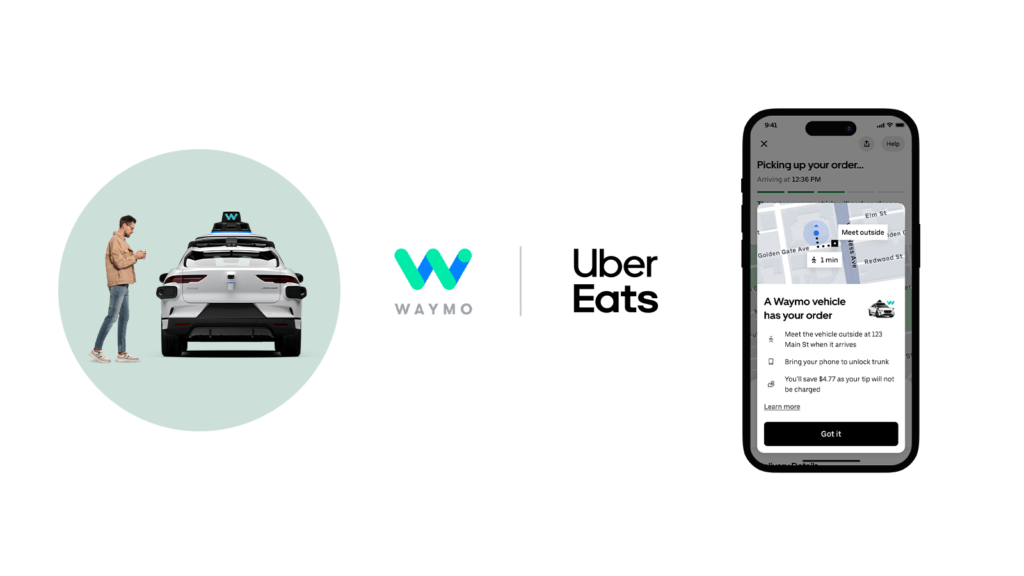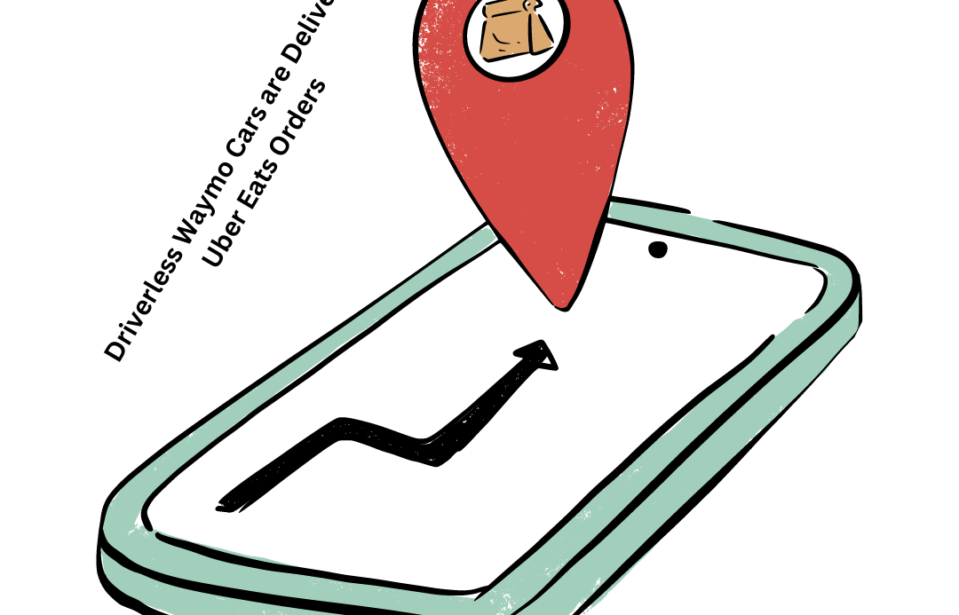In Phoenix, a customer had a unique experience with their Uber Eats order delivery. Instead of the usual interaction with a delivery driver, an autonomous Waymo car arrived with their meal. The customer simply had to approach the vehicle, which was waiting at the curb, and press a button to retrieve their order.
This encounter highlights the growing presence of robot delivery services, causing concern among some delivery workers about the potential for robots to replace human jobs sooner than expected. The use of autonomous vehicles, such as the Waymo car, raises questions about the future of the delivery industry and the potential impact on employment.
Let’s dive deep into how driverless Waymo Cars for Uber Eats deliveries work.
The Partnership Unveiled
The collaboration between Uber and Waymo was first announced last year, revealing a multi-year partnership aimed at integrating autonomous vehicles into ride-sharing and delivery services. In October 2022, Uber initiated this partnership by offering rides in Waymo’s self-driving cars through its ride-hailing service in Phoenix. Now, Uber Eats joins the fold, introducing driverless food delivery to its platform.
How It Works

Image source: waymo.com
For Uber Eats customers in Phoenix, particularly in the cities of Tempe, Mesa, and Chandler, placing an order could result in a Waymo self-driving car delivering their food. Here’s an overview of the process:
1. Eligible Location and Notification: When customers place an order from a participating restaurant through the Uber Eats app, they may receive a prompt notifying them that their order might be delivered by an autonomous vehicle.
2. Pickup and Unlocking: If assigned to a Waymo car, customers will be alerted through the app, prompting them to head outdoors to unlock the vehicle and retrieve their order.
3. Customer Experience: Customers will need to bring their phones to unlock the Waymo car and access their food. This means stepping outside, as the car won’t deliver to their doorstep.
4. No Extra Charges: Importantly, customers won’t incur additional costs for deliveries made by Waymo cars, which could make this option appealing to those looking to save on delivery fees.
Impact on Uber Eats Drivers
- Significant loss of Uber Eats trips, directly resulting in a substantial decrease in income for drivers.
- Uber may deactivate a large number of drivers as they shift their reliance to driverless Waymo cars for deliveries.
- A noticeable slowdown in the hiring of new drivers by Uber, further reduces opportunities for those seeking employment in this field.
- Customer preference for driverless Waymo deliveries due to lower costs and the absence of tipping expectations.
- Increased competition for fewer available trips, intensifies the challenge for drivers to earn a sustainable income.
- A potential decline in customer engagement and ratings for human drivers as the novelty and convenience of driverless deliveries take precedence.
- Negative impact on driver flexibility and work-life balance, as the availability of trips becomes more unpredictable.
- Reduced opportunities for drivers to build relationships with customers and receive additional requests or repeat business.
- Uber may prioritize the utilization of driverless cars during peak hours, further diminishing the chances for human drivers to secure lucrative trips.
- Potential safety concerns and liability issues for human drivers, as they may be perceived as less reliable or safe in comparison to driverless cars.
- Limited opportunities for drivers to upskill or adapt, particularly if they lack the resources or access to alternative employment options.
Select Merchants for Now
Currently, Waymo deliveries on Uber Eats are limited to select merchants in the Phoenix area, including local favorites like Princess Pita, Filiberto’s, and BoSa Donuts. Uber plans to expand this service to more restaurants and locations over time.
Waymo Deliveries: No Tipping Required, But What About Human Drivers?
One notable aspect of Waymo deliveries is that tipping is not expected or required. In fact, if you choose to tip when placing an order, that amount will be refunded to you after the delivery is completed. This certainly benefits customers and can lead to significant savings over time. However, it raises concerns for human delivery drivers who rely on tips as a substantial portion of their income.
For instance, let’s consider a scenario where an Uber Eats customer tipped $9.10 during checkout, expecting their order to be delivered by a human driver. If that order is instead assigned to a Waymo car, the tip is refunded to the customer, resulting in savings for them. On the flip side, a human delivery worker misses out on that $9.10, which could have made a difference in their earnings for that trip.
This tipping dynamic underscores the complex implications of autonomous delivery. While customers benefit from cost savings, human drivers face the challenge of potentially lower earnings. It’s important to recognize the value of tipping for human delivery workers, who often rely on gratuity as a significant component of their overall compensation.
As autonomous delivery continues to evolve, it’s essential to consider the impact on all stakeholders, including customers, businesses, and human workers. Striking a balance between innovation and fairness will be crucial in shaping a delivery landscape that benefits all parties involved.
Potential Challenges with Waymo Deliveries: Exploring the Downsides
While the concept of Waymo deliveries may evoke a futuristic and innovative image, it’s important to recognize and address some of the problems and inconveniences associated with this autonomous delivery method. Despite its advantages, there are certain aspects where it may fall short compared to traditional human delivery.
One notable drawback is the lack of door-to-door delivery. With Waymo, customers are required to meet the vehicle at the curb to pick up their orders. This can be particularly problematic for individuals with disabilities who rely on having their orders delivered directly to their doorstep. It’s also an inconvenience for those who prefer the convenience and privacy of no-contact door-to-door delivery, which has become increasingly important in the current social climate.
The essence of using delivery apps is often associated with the convenience of having orders brought directly to one’s door. In this regard, Waymo deliveries might be considered a step backward, failing to meet the expectations of customers who value that level of service.
Another challenge arises from logistical issues, specifically parking and communication. Finding delivery locations and securing parking spots can be difficult, as any human driver would attest. In cases where a Waymo car is unable to find legal parking, customers might be inconvenienced by having to walk down the block to retrieve their orders, detracting from the overall convenience of the service.
Furthermore, Waymo deliveries can be less than ideal for restaurant and store employees. Unlike human delivery workers who enter the premises to pick up orders, Waymo cars require employees to go outside and meet the vehicle. This adds an extra step to the pickup process, potentially disrupting the workflow of busy restaurant and store staff.
While Waymo deliveries present an intriguing prospect, it’s important to consider these challenges and their potential impact on the overall delivery experience. Addressing these issues will be crucial in ensuring that autonomous delivery not only sounds futuristic but also provides a seamless and satisfactory experience for all stakeholders involved.
Driverless Cars: Are Robots Really Taking Over?
For years, the fear of robots taking our jobs in the rideshare and delivery industry has loomed large. And now, the technology that seemed like a distant dream is becoming a reality. But will Waymo and other autonomous delivery services truly replace human workers?
It’s important to note that Waymo’s current service is only a pilot program in select test markets. There are still numerous logistical challenges to be addressed before autonomous delivery can fully replace human workers on a large scale.
One key consideration is the economics of using expensive autonomous vehicles for low-paid deliveries. It may not be cost-effective to deploy a $200,000+ vehicle for such tasks when there are cheaper alternatives available.
So, while robots may not be taking over all our jobs just yet, it’s clear that they will soon play a significant role in certain sectors. The future of work is undoubtedly going to involve a mix of human and robotic labor, and it’s important that we prepare for this transition and ensure that the benefits of automation are shared fairly across society.
Join our buzzing community of rideshare drivers where you can connect with your fellow drivers and discuss any questions or insights you may have about the rideshare world. Whether you’re a seasoned driver or just starting, our community is a space to share experiences, seek advice, and find support from those who understand the unique challenges and joys of being a rideshare driver.





Leave a comment